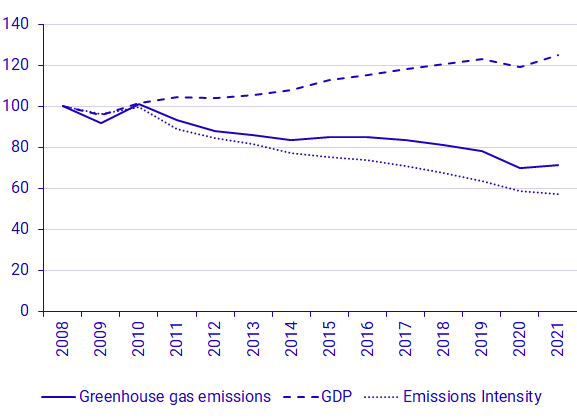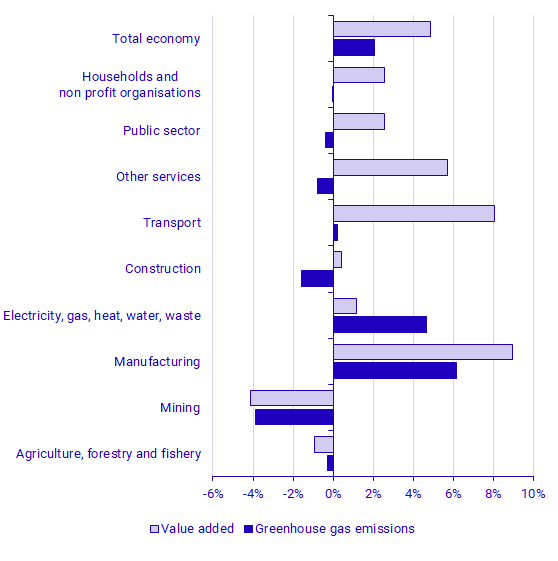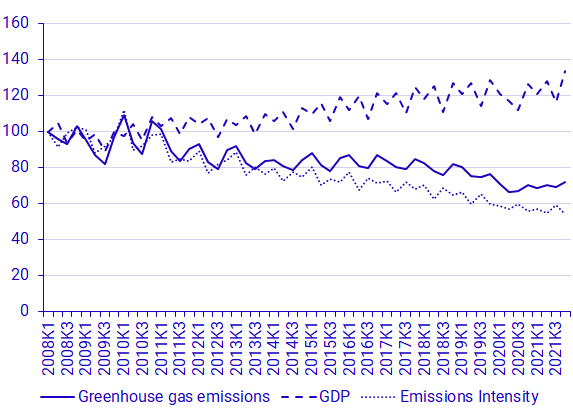Environmental Accounts – Emissions to air Q4 2021
Greenhouse gas emissions from Sweden’s economy increased in 2021
Statistical news from Statistics Sweden 2022-05-12 8.00
Greenhouse gas emissions from Sweden’s economy increased by 2.1 percent in 2021 compared to 2020 according to preliminary statistics. The increase occurred mainly in the energy sector and the manufacturing industry. Sweden’s GDP increased by 4.8 percent over the same time period.
Preliminary statistics on greenhouse gas and other air emissions from Sweden’s economy are now available from Statistics Sweden environmental accounts. The statistics are classified according to economic activity and include emissions from all Swedish economic actors, including households. The preliminary statistics for 2021 are a summation of quarterly statistics, where the fourth quarter is now ready. The final statistics for 2021 will be published in March 2023.
Total greenhouse gas emissions from Sweden’s economy were 48.7 million tonnes of carbon dioxide equivalents in 2021. This is an increase of 2.1 percent compared to 2020. Over the same time period, Sweden’s GDP increased by 4.8 percent. Greenhouse gas emissions in 2020 and 2021 were significantly affected by measures to mitigate the Corona pandemic. Greenhouse gas emissions in 2021 were 8.7 percent lower than in 2019, the latest year not affected by the Corona pandemic.
The economy’s greenhouse gas intensity, that is greenhouse gas emissions per Swedish krona of economic production, decreased by 2.6 percent in 2021.

Source: Statistics Sweden.
Increased emissions from the energy sector and manufacturing industry
Greenhouse gas emissions increased in 2021 compared with 2020 principally in the energy sector and manufacturing industry.
In manufacturing industry, greenhouse gas emissions increased by 6.1 percent in 2021 compared to 2020, an absolute increase of 0.8 million tonnes of carbon dioxide equivalents. At the same time economic production (measured as value added) increased by 8.9 percent. The largest increase occurred for the manufacture of petroleum and chemicals, where greenhouse gas emissions increased by 13.9 percent. Greenhouse gas emissions from iron and steel production increased by 7.7 percent in 2021 compared with 2020.
In the energy sector (including electricity, gas, heat as well as water and waste) greenhouse gas emissions increased by 4.7 percent in 2021 compared to 2020, which can be linked to increased use of fossil fuels. Use of fossil fuels in the energy sector tends to increase with lower outdoor temperatures, and 2021 was a relatively cold year.
Greenhouse gas emissions from the transport sector and from households were relatively unchanged in 2021 compared with 2020. The transport sector includes aviation, maritime transport and road transport. Households’ emissions come principally from fossil fuel use in cars.
| NACE 2007 industry | Greenhouse gas emissions | Value Added | ||||
|---|---|---|---|---|---|---|
| 2021 | Change compared to 2020 |
2021 |
Change compared |
|||
| Agriculture, forestry and fishery | 8 708 | ‑23 | ‑0,3% | 68 629 | ‑635 | ‑0,9% |
| Mining | 841 | ‑34 | ‑3,9% | 32 238 | ‑1 393 | ‑4,1% |
| Manufacturing | 13 635 | 789 | 6,1% | 658 834 | 54 038 | 8,9% |
| Electricity, gas, heat, water, waste | 6 851 | 306 | 4,7% | 119 603 | 1 391 | 1,2% |
| Construction | 1 725 | ‑28 | ‑1,6% | 297 765 | 1 262 | 0,4% |
| Transport | 4 924 | 11 | 0,2% | 175 971 | 13 125 | 8,1% |
| Other services | 3 147 | ‑25 | ‑0,8% | 2 278 705 | 122 581 | 5,7% |
| Public sector | 398 | ‑2 | ‑0,4% | 946 704 | 23 695 | 2,6% |
| Households and non-profit institutions [1] | 8 455 | ‑5 | ‑0,1% | 58 178 | 1 448 | 2,6% |
| Total economy | 48 685 | 990 | 2,1% | 5 226 683 | 239 419 | 4,8% |
Source: Statistics Sweden.

[1] Only non-profit institutions provide value added. Source: Statistics Sweden. [2] GDP with a production approach.

Greenhouse gas emissions increased in the fourth quarter of 2021 in the transport and energy sectors
Greenhouse gas emissions in the fourth quarter of 2021 were 12.5 million tonnes of carbon dioxide equivalents. This is an increase of 2.4 percent compared to the same quarter in 2020. GDP was 5.7 percent greater in the fourth quarter of 2021 compared with the same quarter in 2020.
In the transport sector, greenhouse gas emissions were relatively unchanged in for the year 2021 compared to 2020. However, the quarterly emissions show notable variations. In the first quarter of 2021, greenhouse gas emissions from the transport sector were lower compared to the same quarter in 2020, largely due to decreased emissions from aviation in connection with measures to address the Corona pandemic. However, for the second, third and fourth quarters of 2021, emissions from the transport sector were higher compared to the same time periods in 2020. In the fourth quarter of 2021, greenhouse gas emissions from the transport sector were 9.5 percent higher compared with the same quarter in 2020. Value added in the transport sector increased by 12.2 percent in the fourth quarter of 2021 compared to the same quarter in 2020.
Greenhouse gas emissions from the energy sector (including electricity production, district heating, gas as well as water, sewage and waste) increased by 12.1 percent in the fourth quarter of 2021 compared with the same time period in 2020. Added value in the sector increased by 2.7 percent over the same time period. Greenhouse gas emissions for manufacturing industry increased by 1.9 percent in the fourth quarter of 2021 compared with the same quarter in 2020. Value added increased by 4.3 percent over the same time period.
Definitions and explanations
The System of Environmental Economic Accounting (SEEA) is constructed using the national accounts as a foundation and presents environmental and economic statistics in a common system. The SEEA makes it possible to analyse interactions between the economy and the environment. The starting point is Swedish economic actors’ environmental pressures, irrespective of where in the world they occur.
The statistics produced here use a production perspective. This means that emissions are allocated to the actor and sector that produces the emissions. Indirect emissions arising due to imports and other consumption are not included.
The statistics produced here are not used directly to measure emissions in relation to nationally and internationally agreed climate targets. Statistics with a territorial perspective are used for that purpose. More information about different perspectives for emissions accounting is available on the Swedish Environmental Protection Agency’s website (in Swedish):
Tre sätt att beräkna klimatpåverkande utslapp
A residence adjustment is applied to adapt statistical sources with a territorial perspective used to produce these statistics to the national and environmental accounts’ economic perspective. The residence adjustment applies primarily to transport: heavy-duty road transport (primarily within H49 land transport companies, but also other industries, such as construction), water transport (H50) and air transport (H51). The residence adjustment for heavy-duty road transport is based on data on transport work (in tonne-km) for Swedish companies abroad and foreign companies in Sweden, with data from Transport Analysis (Trafikanalys). For water transport the residence adjustment is based on data for swedish companies´ expenditure on fuel from Statistics Sweden´s database on intermediate use in the economy, PRIOR. For air transport, the residence adjustment is based on data from the OECD on carbon dioxide emissions from air transport - Air transport CO2 emissions (oecd.org). These data are based on register data of flight including the home base of flight operators an departure and arrival airports and are therefore judged to be of high quality.
Emissions and sequestration due to land use (LULUCF) and carbon dioxide capture and storage (CCS) are not included in the statistics.
Modelling assumptions for mobile emissions
For the reference periods 2008 Q1 – 2017Q4 and 2020Q1 onwards, the air emissions for non-road machinery, road transport and aviation have been calculated with the monthly fuel, gas and inventory statistics as a source. For reference periods 2018Q1 – 2019Q4 the register of reports to the Swedish Energy Agency in accordance with Sweden’s implementation of the EU’s Renewable Energy Directive (2009/28/EC) have been used to calculate the air emissions from these sources. The reason for returning to the monthly fuel, gas and inventory statistics as a source beginning 2020Q1 and onwards is that producers of these statistics assess the data for those time periods to be of high quality. Comparisons between the period 2018Q1 – 2019Q4 and other periods in the time series should therefore be done with care.
Next publishing will be
The next item of statistical news on quarterly emissions to air, for the first quarter of 2022, is scheduled for publication on 1st September 2022.
Statistical Database
More information is available in the Statistical Database
Feel free to use the facts from this statistical news but remember to state Source: Statistics Sweden.
